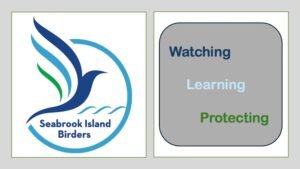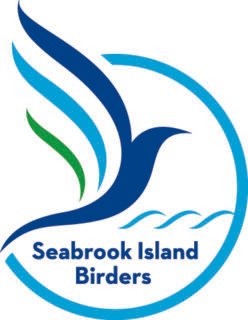
What happened in 2024
They say the older you get, the quicker time passes. I believe this, as it’s early December and I’m still trying to figure out where summer went. They also say time flies when you’re having fun. This too, is true, and for birders, there’s nothing better than a day of great weather, time spent outdoors with friends, and 50 birds on your eBird list!
It’s been a busy and fruitful year for Seabrook Island Birders. For those of you who don’t consider yourself a birder, you might wonder what on earth you could do to fill your calendar with 12 months of bird activities!
So, let’s recap. And for those of you who haven’t yet realized you’re a birder, you might find something that intrigues you enough to join us in 2025.
We started the year in early January, joining thousands of others around the country by participating in the nation’s longest-running community science bird project, the Audubon Christmas Bird Count. Five teams of birders spread out over Seabrook Island birding “hot spots,” and collectively saw 101 species and counted 2,074 individual birds, in 24 hours! We walked 21.4 miles, drove 3.3 miles in a car, 13.8 miles in golf carts, for a total of 53 people hours of effort. We also had ten backyard feeders where homeowners saw 70 species and 347 individual birds. A full day of birding!
Next was an island favorite – an evening presentation by Stephen Schabel from the Center of Birds of Prey. Stephen combines his background in education and environmental policy with his lifelong passion for the outdoors, and especially birds. As Vice President and Director of The Center for Birds of Prey & Education, Stephen is not only a wealth of knowledge, but he always brings along feathered friends who manage to steal the show. We’ll have the pleasure of hosting them again in January, so stay tuned!
In February we moved full swing into shorebird season, welcoming and training new volunteer Shorebird Stewards. As Red Knots and other migrating shorebirds pass through on their way to the Arctic, we take the opportunity to spend time on the beach, greeting visitors and residents, and sharing the migration stories of these incredible birds. This year our team had the pleasure of interacting with beachgoers a total of 840 times! That’s 840 times a resident or visitor had the chance to look at shorebirds through the scope, learn why it’s important to share the beach, and even download a QR code to learn more.
In 2024 we also had a unique opportunity to contribute to shorebird science. Through the generous donations of our dedicated members and residents, we raised funds that allowed us to purchase a custom-made net. A net that we would excitedly hand over to SC DNR, to assist with Red Knot trapping and banding – a critical technique to facilitate research on migration and nesting.
In keeping with our educational mission, we offered numerous evening presentations this year. We learned about South Carolina’s role in the survival of Arctic nesting shorebirds; Audubon South Carolina’s vision for critical issues such as habitat conservation and restoration; and furthered our knowledge of future conservation efforts in SC through the efforts of the Open Space Institute. A lesson in Ornitherapy this fall; then information about Pelagic birds, completed our evening presentations for the year.
Over the summer months we held our first Bird Camp – a series of children’s workshops focused on bird feathers, their structure, and purpose. Classroom work and field work combined to make this a great event for kids, giving them hands-on education in a fun and engaging environment.
In the spring we watched bird parents brood, hatch, and care for their young, an exhausting task. We said goodbye to our winter birds and welcomed our spring/summer birds to the island, as well as spent several weeks happily searching for migrating birds just passing through. We did the same in the fall, as summer birds flew south, and our winter favorites returned. It’s safe to say we’re happy to see our mergansers on the ponds and lagoons again!
Other projects are on-going, like the Eastern Bluebird Trail on Seabrook Island. Volunteers monitor and protect 71 nesting sites, located on Ocean Winds Golf Course, Crooked Oaks Golf Course, and at the Lakehouse. Nesting season runs from March through August, with up to 3 nesting cycles per nestbox! Repair and maintenance of the boxes takes place in the off season.
To make the most of the birds we saw this year, SIB members once again contributed their sightings to a shared eBird list, giving us our own unique “Big Year.” This year so far, we’ve seen 633 species, with more expected to be added by the end of the year.
A discussion among SIB members about the behaviors and habitats of Purple Martins led to the conception of a new project. Did you know Purple Martins on the east coast rely solely on humans for housing? This Purple Martin “Landlord” project is in the works and will be making its debut at the Equestrian Center in the new year!
And let’s not forget our monthly walks and activities. We birdied the golf course 12 times, went on 18 walks on and around the island, and traveled beyond our backyard 19 times! We “walked off the bird” the day after Thanksgiving, were delighted to see three Reddish Egrets at the same time on North Beach and had the joy of spotting vagrant Magnificent Frigatebirds over our beaches, blown off course from storms.
At the time of this writing, our communications team has published 245 blogs, welcomed 73,303 visitors to our website, and posted at least one photo every day on our Facebook and Instagram pages. Plus, twelve articles in The Seabrooker! Needless to say, we’re excited about what we do and love to share our enthusiasm for our island birds.

Authored by Gina Sanders Communications Chair Seabrook Island Birders
